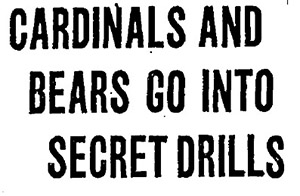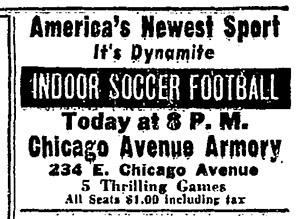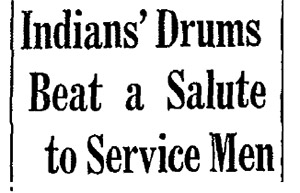In addition to outside groups holding galas in the armory's top floor ballroom, and ongoing polo and other horse-related events bringing the public into the ground floor arena, other special events and gatherings took place at the Chicago Avenue Armory.
Chicago Daily Tribune, October 18, 1936

"The first session of a girls' basketball instruction school will be held
this morning at 11 o'clock at the 122d armory, 234 East Chicago avenue."
****************************
Chicago Daily Tribune, September 24, 1950

Chicago's South Side All Breed Club's "Obedience Classic" was held at the armory in the fall of 1950.
Chicago Daily Tribune, November 29, 1950

Like today's baseball rivalry between the Chicago Cubs and White Sox,
for several decades at the beginning of the 20th century, the city had rival football teams: the Chicago Bears and Cardinals who played their home games at Wrigley Field and Comiskey Park, respectively. This newspaper article details the teams' clandestine practice activities in preparation for a standoff at Wrigley Field. "The Cardinals, as previously announced, worked behind locked doors in the University of Chicago field house in the morning... The Bears were just as hush-hush. Without any advance notice they vetoed a morning workout in Wrigley field and exercised in the Chicago Avenue armory. A reporter, stopped at the armory office, was not admitted to the arena until identifed by Frank Halas, traveling secretary of the Bears, and brother of George Halas, the owner-coach."
Chicago Daily Tribune, December 13, 1950

Originating in 1949, and continuing for nearly 30 years, the Chicago Avenue Armory's arena hosted the National Soccer League's games. In a 1979 Chicago Tribune article by Mike Conklin, titled,
"National Soccer League changes with 'the times'", he began:
"For almost 30 years, it has remained a Chicago sports institution in the most unlikely setting - a dirty, smelly building that shows no mercy toward those with sensitive noses or light-colored clothing. It is a Chicago institution in the same mold as wrestling at Marigold, Windy City softball, Riverview amusement park, or the football Cardinals - local landmarks victimized by that cruelest killjoy, "the times." but indoor soccer in the Chicago Avenue Armory somehow has survived. It has survived the occasional violence that breaks out during the games in the crowd and on the field. It has survived the internal bickering of the National Soccer League officials who govern it. It has survived the ethnic hatreds brought over from Europe. Perhaps, most astonishingly, it has survived the Chicago Avenue Armory, that dusty, old field house with practically no creature comforts located so incongruously in one of the city's most affluent neighborhoods."
Like arena polo, indoor soccer provides a smaller space and its teams have fewer members. Also, rules are modified for the scaled-down games, and the play is faster.
Conklin's article goes on to recount a little of the soccer league's history, which was comprised mostly of ethnic-based clubs with exotic-sounding names that sometimes indicated the team's origin: Olympics, Vikings, Hakoah, Necaxa, Norse.
He wrote of some of the rivalries, which were amplified by the indoor sport's speed and enclosed quarters:
"Most of the clubs, especially the Croatians, have a noisy following, and it can get exceptionally passionate when it's Croatians vs. Serbians, Liths vs. Schwaben (German), or Wisla or Eagles (Polish) vs. Green-White (Germans) or Rams (a mixture.)... Several years ago, the league suspended the Olympics, a Greek team, for six months when one of its followers ran on to the field and almost started a riot."
Ethnic and independent groups used the armory for events and gatherings that now indicate their historical significance.
According to the City University of New York's spring 2004 (pp. 140-152), Centro Journal article, titled, "Five Decades of the Puerto Rican Music Scene in Chicago: A Personal Recollection," Carlos Flores wrote of the Chicago Avenue Armory playing a significant role in Chicago's Puerto Rican community's history. Six thousand visitors came to the Chicago Avenue Armory on the day of their 1956 event.
"The first major Chicago Puerto Rican Festival was held on June 24, 1956, when the Caballeros de San Juan (Knights of St. John) organized El Dia de San Juan Festival in conjunction with the same holiday on the island... The festival was held at the Chicago Avenue Armory , and it featured the museum of Tito Rodriguez and his Orchestra, Trio Vegabajeno, and a Mexican comedian by the name of Pecas. Dona Felisa Rincon de Gautier, the mayor of San Juan, was an invited guest, and an estimated 6,000 Puerto Ricans attended the festivities."
****************************
September 24, 1958

The Native American community also utilized the Chicago Avenue Armory's arena for an event that would become a yearly occurence. The short Tribune item, above, said the event was called, North American Indian Days, was sponsored by the National Indian Foundation, and that the proceeds would go to "aid needy among about 9,000 American Indians in Chicago."
November 12, 1967

November 27, 1970 - 14th annual Native American event

****************************
The Chicago Avenue Armory also hosted other horse and animal-related events through the 1960s:
October 15, 1963

October 2, 1965

****************************
On April 20, 1969, a Chicago Tribune item noted that the "Uptown community's Nisei Ambassadors drum and bugle corps will open its 1969 season with a concert at 7:45 Saturday in the Chicago avenue armory."
****************************
Also in 1969, reporting on a yearly arrangement, the Chicago Tribune wrote that the Medinah Shrine Circus animals were kept in the armory, from which in a colorful procession, they paraded four blocks down Michigan Avenue to the Medinah Temple.
March 13, 1978

In a tragic occurrence that led to the death of a circus animal-keeper inside the Chicago Avenue Armory, the Chicago Tribune and other national newspapers reported that what had initially been thought of as an accident
was the result of ongoing animal abuse.
Joyce, the 8,000 pound elephant, was being handled by a trainer who was supposedly drunk and showing off to some polo players in the area where their horses were also kept. The trainer had sat on the elephant's knee and wrapped her trunk around him, at which point she threw the trainer against one of the armory's giant concrete columns.
December 23, 1988

One of the last organizations who remained using the armory's arena up until its final days was called, Friends of Handicapped Riders. In this article by Beatrice Michaels Shapiro, the group, which was accredited by the National American Riding for the Handicapped Association, "aids physically, mentally and emotionally handicapped people in learning to ride horses."
The therapeutic horse riding group used the Chicago Avenue Armory's arena from 1975 through 1991.